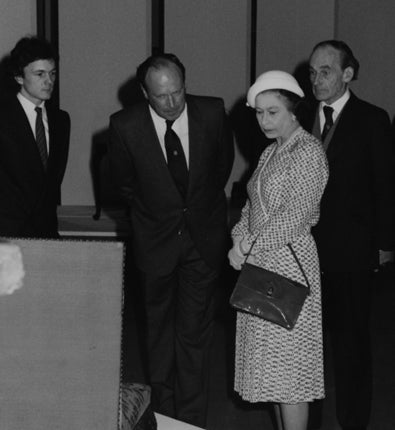David Learmont: Inaugural curator at the National Trust for Scotland who transformed a host of prestigious properties

David Learmont was the first holder of the position of curator in the National Trust for Scotland.
A gifted man, of demonic energy, dedicated to the aims of the Trust, and of good, if controversial taste, Learmont was never in the inner councils of NTS headquarters at Charlotte Square, in the way that the curator in England was central to the decision-making of the English Trust. He was a "doer". He loathed sitting in long-winded committee meetings. He was on the proverbial road, at properties, often preparing for public viewing houses that had been allowed to become chaotic and shabby.
David Murray Learmont was born in Hovingham, where his father was a doctor; among his patients were the great Yorkshire family of Worsley. Childhood familiarity with their beautiful house, full of treasures, gave him a love of furniture and elegant objets d'art. After school at Sedbergh, at the time under the inspirational headmastership of Bruce Lockett, Learmont went to Switzerland to learn the culinary arts at the celebrated Hotel School at Lausanne. Among his life-long abilities was that of being a superb cook.
Returning to Britain, he applied for posts in the private sector of primary schooling, and was appointed a master at Isleden Court preparatory school and spent 12 happy years there from 1955 to 1967. When he was passed over for the headmastership he went to Dulwich College prep school, between 1967 and 1970, then came to the notice of the long-term director of the National Trust for Scotland (later Sir) James Stormonth Darling. He became a founder member of the Furniture History Society.
By 1970, Stormonth Darling and his chairman, the Earl of Wemyss, a shrewd judge of character, were becoming impatient with scholars and dilettantes. They wanted as their first curator a man who would actually roll up his sleeves and get down to work in presenting the properties – which NTS was acquiring thick and fast from a Scottish aristocracy whose next generation, as Wemyss acidly put it, "were deserting their posts". Stormonth Darling and Wemyss took a chance on Learmont and his wife, Ann, a descendent of the Granville family who had been alongside William Wilberforce in the anti-slavery campaigns. Learmont was to fulfil their requirements for the next 27 years.
During the 10-year period in which Lester Borley was director of NTS (Borley having succeeded Stormonth Darling), it did not matter that the curator was absent from important committee meetings since Borley himself, later the driving force in the British section of Europa Nostra, supplied the scholarship and expertise in art which was sometimes necessary in putting the curatorial case.
He did not claim to be a scholar of the calibre of the curators who worked in the English Trust. But as an "action man", leading the dedicated team of Christopher Hartley and John Batty, he achieved necessary transformation at an array of houses, ranging from the mighty Culzean Castle on the Ayrshire coast to the House of Dun, Kellie Castle and Falkland Palace in Fife. He also turned his attention to the great Aberdeenshire properties such as Castle Fraser, Crathes Castle, Craigievar Castle and smaller properties such as Hugh Miller's Cottage in the Cromarty Firth Black Isle and the little houses at Dunkeld in Perthshire. One of his many triumphs was setting up the fascinating kitchen of the Georgian House, near NTS headquarters, in Edinburgh's Charlotte Square.
Learmont had a particular gift, invaluable in a curator of National Trust for Scotland houses, of an absolutely outstanding eye for the right carpet. As NTS's first curator, he was asked to furnish – or in Scots parlance, "find furnishings" – for rooms in recently acquired houses that had either been neglected, or had lost contents to the extended families of previous owners. Learmont's astonishing capacity to remember the ambience of many rooms and their exact dimensions was a tremendous attribute in his many, many visits to Edinburgh sales rooms on behalf of NTS.
He was responsible for a great deal of outstanding acquisitions. His detractors would mutter that, "David is a first-class interior decorator" and would use the somewhat derogatory term "Learmontising" to describe what they perceived as the stereotyping of the interior of NTS properties. In my opinion, and that of my wife as property managers at the House of the Binns, given by my mother in 1944, this was unfair. Learmont's aim was to show NTS houses as the sort of homes in which people would wish to live, surrounded by paintings, and plenishings of cultural and historic interest and importance.
Learmont also had an asset that perhaps can be misinterpreted, but was, in fact, an inestimable benefit to NTS. He charmed elderly ladies, with a cocktail of teasing and respect. But he was genuinely, and not synthetically, charming. One result was that NTS was bequeathed a lot of serious money in the form of legacies which the trust would not otherwise have had.
David Murray Learmont, curator, National Trust for Scotland, 1970-1997: born Hovingham, Yorkshire 19 June 1935; married 1960 Ann Granville Sharp (two sons); died Malleny, Midlothian 21 July 2009.
Subscribe to Independent Premium to bookmark this article
Want to bookmark your favourite articles and stories to read or reference later? Start your Independent Premium subscription today.

Join our commenting forum
Join thought-provoking conversations, follow other Independent readers and see their replies